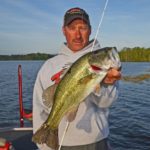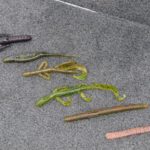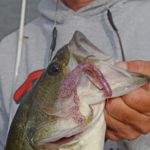
If you’re looking to catch more bass at Toledo Bend, this angler said there’s one rig that will produce day in, day out. And it’ll catch numbers or big fish — all you have to do is know how to adjust.
The sky was still black when Dusty Anders pulled up to Toledo Town & Tackle, the pit stop/tackle store on the corner of Highways 6 and 191 near Toledo Bend Reservoir.
I counted 32 fiberglass bass boats in the lot. I did some quick math and came up with $1.6 million sitting there.
And then there were the trucks pulling them — all new or nearly so and mostly full-sized, heavy-duty, four-wheel drive rigs.
It was a weekday and there weren’t any tournaments going on — just regular fishin’.
On top of that, the weather was iffy.
Earlier, when I woke up and walked into the living room of Anders’ camp in La Nana, he looked away from the TV he was studying.
“Well, we have Mother Nature to contend with this morning,” Anders said.
I stuck my head out the door. The wind was howling.
“That’s what’s bad about Toledo Bend,” Anders grumbled. “Most places, the wind lays down at night. Not here.”
We went anyway. I was determined to pick Ander’s mind about Carolina rigs, one of the most versatile and productive lures in a bass fisherman’s arsenal.
The Carolina rig certainly came after the invention of the Texas rig in the late 1950s. It had been in quiet use, however, well before Jack Chancellor won the 1985 Bassmasters Classic on the Arkansas River using a version of the contraption.
Professional anglers now use Carolina rigs much more often than the slower-to-fish Texas rig. Many consider it their go-to rig.
Anders calls it, “a numbers bait.”
“It’s good for fun fishing — but it can also catch big fish,” he said. “That’s what I like about it.”
The angler took me to a 10-foot-wide ridge several hundred yards from the reservoir’s shoreline. The ridge dropped off to 35- to 49-foot depths on both sides.
Without looking at electronics, the only thing that gave its presence away was the vegetation growing on the ridge’s crest.
We got there early and, even in the dim light, Anders could see bass working the shallows on top of the ridge, chomping on spawning shad.
Even though we were there to fish Carolina Rigs, he couldn’t resist picking the low-hanging fruit and began tossing a SPRO pop frog, with immediate results.
The hay grass the fish were in is not good for Carolina rigs anyway, he explained.
“It’s as tough a grass as you ever put a bait in,” Anders said. “You need something topwater, like a frog or a swimbait.”
Learning to locate ridges and determine which ones are better through trial and error, he said while casting.
The best spots are where creeks are closest to the crest of a ridge, usually where the creek makes a hard turn.
Twenty minutes and half a dozen good fish later, the bass stopped biting the frog.
Anders said the fish were likely moving toward deeper water, and he tried a spinner bait on them — adding several more bass to his catch.
He quickly shifted to a Carolina rig featuring a cotton candy-colored lizard, which he stayed with the rest of the day.
He explained the rig’s virtues.
“It’s a good search bait. It doesn’t wear you out like crankbaits do,” Anders said. “It keeps you in contact with the bottom, so you can learn the texture of the bottom in the area. A mooshy bottom isn’t as good as other bottoms. I don’t like to fish there.”
Carolina rigs also provide a lot of options.
“They are versatile,” Anders explained. “A craw worm, a Fluke, a lizard, a Brush Hog, a big worm, a Senko, a french fry — you can put anything on the back of it.
“And it’s a 12-month lure — most definitely.”
About all that changes throughout the year is the best lure to thread on the hook.
“January and February, I start off throwing 8-inch lizards, looking for big prespawn females,” Anders said. “I target staging areas in water 12 to 15 feet deep, at points off the ends of ridges and flats.
“From March to May I go to smaller baits, 6-inch lizards, creature-type baits or flukes. It’s spawning season, so I fish the tops of ridges and flats in 10 feet or less of water.”
Lures are upsized when the heat cranks up.
“With summer — June through September — I switch to 6- to 8-inch worms for numbers of fish and 10- to 11-inch monster worms for size,” Anders explained.
And with the fall, it’s time to move to baitfish-type lures.
“… (I)n October, when the water cools down, and through December, I like shad imitations, like flukes,” he said. “I fish up creek arms that are up to 30 feet deep. I fish the sides of the creek 8 to 10 feet deep early in the morning and 14 or 15 feet deep later in the day.”
For Anders, Carolina rigs are simple affairs. He begins by threading a bullet-shaped sinker on his line, pointed end forward. In waters 15 feet deep or less, he uses up to ½-ounce weights, while in 15 to 25 feet of water he prefers ¾- to 1-ounce versions.
These produce very heavy Carolina rigs, for a reason: He gets more casting distance and he can feel the bottom better.
He dismissively calls lighter models “dinky rigs.”
Then Andyers adds a couple of glass or plastic beads (preferably rattlers) and ties on a swivel.
This is followed by a 5-foot length of 15-pound-test Vicious monofilament for a leader. He prefers mono over fluorocarbon for leaders because the former is more buoyant.
A 2/0 offset hook tops off the rig.
Almost any sort of soft-plastic lure can be used on a Carolina rig, although Anders is partial to those made by Crème Lure Company in their Same Thing series — knock-offs similar to lures produced by other companies.
“They use tougher plastic than other makers, so I can catch more fish on each lure and they are cheaper,” he said.
Anders is such a good customer that Crème makes special pourings for him.
His basic technique was simple: He made 1- to 2-foot sideways sweeps with his rod tip after allowing the rig to settle.
“The concept is to keep the sinker in contact with the bottom at all times,” Anders explained. “It’s not like a Texas rig, where you lift it up. With a Texas rig you momentarily lose contact with the bottom.”
Lure color has become critical, he believes.
“Fishing pressure is through the roof, and the fish are more educated now,” Anders said. “You could get away with two or three colors 25 years ago. You need to change colors more often now.
“For example, I carry 15 colors of lizards.”
Anders is convinced part of the issue stems from Florida bass.
“They are very, very finicky as to colors,” he said.
He cited a recent trip during which he drew a blank with watermelon seed lizards; then he changed to blue watermelon and caught 20 fish.
He typically begins the year using darker, more-opaque plastics such as Junebug red and pumpkinseed, shifting to more-translucent and lighter-colored lures such as cotton candy, watermelon seed and blue watermelon as the waters of Toledo Bend become clearer.
While, as noted above, Anders changes lure sizes with seasons, he makes exceptions for tournaments — particularly those like the McDonald’s Big Bass Splash held in the latter half of May each year.
Here, only one big bass is weighed in daily to win, so he sticks with a large lure to attract that one large fish.
Ander’s day went well on our trip, in spite of the early wind threat. With the exception of one 10-minute period of bank-beating, he fished offshore the entire day.
He boated and released dozens of bass.
I had to make him quit.



